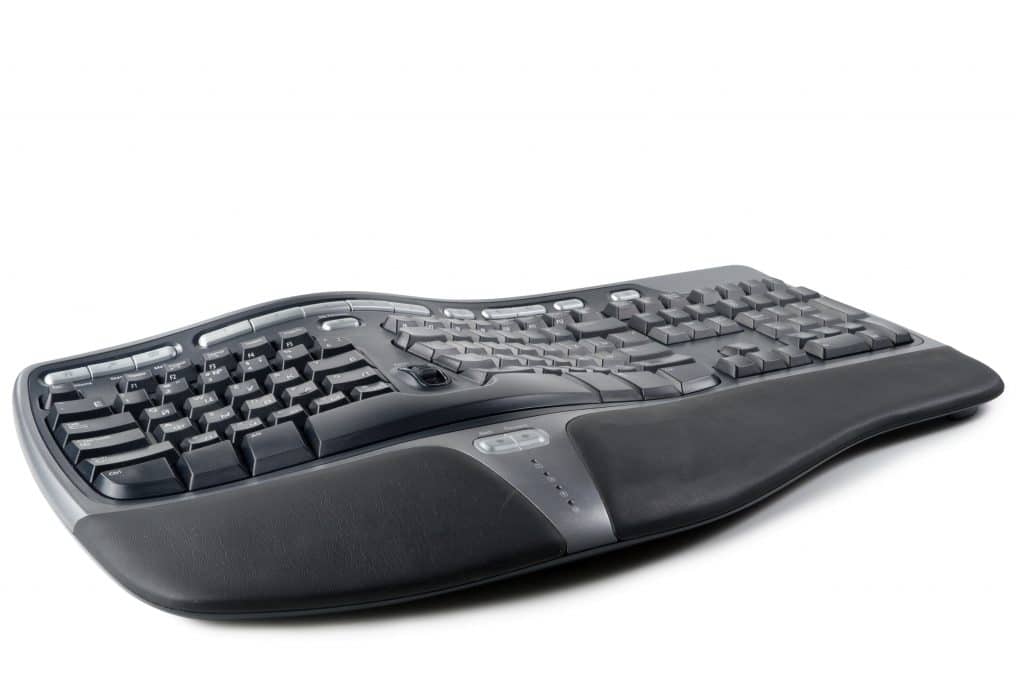KEY TAKEAWAYS: Getting the wrong keyboard can cause serious health issues in the long term, so it’s important to take the proper preventative measures now. Here are a few things to consider when setting up your workstation.
Jump Ahead
For most Canadians, a keyboard is a bit of an afterthought in their workstation, with many of us simply using the one that came with our computers. However, these keyboards can be uncomfortable and potentially cause injuries. Although many people can use standard keyboards comfortably if they keep their hands as flat and straight as possible, years of use can cause severe damage to hands, wrists, and shoulders. And, most of us will not realize there is a problem until it becomes serious.
Repetitive strain injury (RSI) is one of the most severe conditions associated with long-term keyboard use. According to Statistics Canada, 15 percent of Canadian adults have had a repetitive strain injury serious enough to limit normal activities. These strain injuries include carpal tunnel syndrome, a common condition in which the pressure on the median nerve becomes intense enough to crush it. It can cause numbness, tingling, burning, or pain in the hands and wrists. In many cases, surgery is the only cure.
Repetitive strains, including carpal tunnel, result from repetitive movements or holding parts of your body in static positions for long periods. Choosing the right keyboard can help prevent these kinds of strains to your hands, wrists, and shoulders. Here are a few tips for finding the right keyboard.
Consider size and shape
Ergonomic keyboards can come in split layouts where the keyboard is essentially split in half or in single-piece layouts. There are advantages and disadvantages to both.
Look for a keyboard that decreases unnatural wrist positioning and promotes natural wrist positions. It should offer a shape that fits your usual use patterns and encourages your hands and wrists to adopt good posturing.
Split keyboards create a natural space between the two halves of the keyboard so that your hands are resting in a more natural position. Tented keyboards tilt up like a tent and serve a similar purpose. However, the learning curve for a split or tented keyboard can be substantial. It can take time to develop the ability to type quickly on one, particularly if you are used to a standard keyboard setup. This is also true for a curved unibody model. Both are designed to straighten the wrists and arms to a more neutral position. Though it may be frustrating for a while, these types of keyboards can be incredibly helpful in decreasing the strain on your hands and wrists.

Look for a compact keyboard size, one that fits the natural width of your shoulders to encourage good posture. A compact keyboard will also ensure your fingers are not straining to reach certain keys. However, keyboards that are too small, like those found on a laptop, can also contribute to stressful postures and lead to contact stresses on the tendons in your wrist. OSHA standards suggest that the horizontal space between the centers of two keys should be 18 and 19 mm, and vertical spacing between 18 and 21 mm.
Keep the tilt in mind
Keyboard tilt is usually described as positive, neutral, or negative. Positive tilts raise the keyboard at the back and tip the keyboard towards you. This allows you to see the keys, which is helpful if you are not a non-touch typist, but this also puts unnecessary strain on your wrists.
A neutral keyboard tilt rests your keyboard flat on your desk, and it’s a better choice for keeping your wrists comfortable. It helps reduce strain on the carpal tunnel and its median nerve, leaving the tendons with a free range of motion. To benefit from this type of keyboard, you should be sitting straight or reclining slightly.
The most ergonomic choice is a slight negative tilt. This tilts the keyboard down slightly at the back and up at the front. This tilt fits the shape of the hand better and avoids putting additional pressure on the tendons and carpal tunnel through a slight upward bend of the wrist that you get when using a neutral position.
Keyboard stands and trays are available that will allow you to put your keyboard in the correct position for you. They’re also sturdier than DIY options and more adaptable than keyboard feet.
Prioritize adjustability
Contoured keyboards are often adjustable, allowing you to adjust the slope of the keyboard to a neutral, positive, or negative position. Look for feet placed at the front rather than the rear of the keyboard. This is known as a reverse tilt, or negative tilt, and allows for more natural wrist placement. Padded wrist pads supporting both your wrists and forearms can help you maintain a healthy and comfortable position.
Examine and adjust positioning
The keyboard you choose should be at or slightly above your elbow height and parallel to your forearms. Avoid keyboards that force you to bend your wrists sideways to reach all keys. If there are feet on your keyboard that place your wrists in an awkward or uncomfortable position, consider closing the feet.
The problem with QWERTY
The QWERTY keyboard standard has been in place since the 1870s, but it isn’t the most ergonomic option. The DVORAK simplified keyboard (DSK) is widely available now and can help reduce awkward positions and providers a shorter distance between keys, reducing the strain of reaching for keys. However, for people who have been typing for years, DSK can have a huge learning curve and it can be incredibly challenging to adjust your typing to the different layout.
As an alternative to the DSK standard, some ergonomic keyboards provide a separate number keyboard and have moved frequently used keys to more accessible positions. When choosing the proper key setup for you, consider the type of work you do and the specialty keys you use most frequently.
Test drive your keyboard
The best way to find a keyboard that is both comfortable and can help you prevent RSI is to try them out. Spend some time, and test drive different styles and keyboard setups. Also, consider compatibility with your other peripherals including your computer, how you place your desk and chair, and your usual posture.
You May Also Be Interested In…
- Do You Have Reasonable Suspicion?
 Employers cannot initiate reasonable suspicion testing without first going through the 5-step process. Reasonable suspicion training provides critical information about how to initiate reasonable suspicion testing, including the 5-step process and other tools that employers can use to help manage the misuse of alcohol and drugs in the workplace.
Employers cannot initiate reasonable suspicion testing without first going through the 5-step process. Reasonable suspicion training provides critical information about how to initiate reasonable suspicion testing, including the 5-step process and other tools that employers can use to help manage the misuse of alcohol and drugs in the workplace. - An Employer’s Guide: What You and Your Employees Need to Know About DOT Drug & Alcohol Testing
 When implementing or maintaining DOT Drug & Alcohol testing, there are key areas that employers should consider.
When implementing or maintaining DOT Drug & Alcohol testing, there are key areas that employers should consider. - SureHire Occupational Testing Acquires COHR Health: A Positive Step Towards Safe, Healthy, Productive Workforces and Communities
 We are thrilled to announce that today, May 6, 2024, SureHire Occupational Testing has officially acquired COHR Health, a well-known leader in occupational health services. Read on…
We are thrilled to announce that today, May 6, 2024, SureHire Occupational Testing has officially acquired COHR Health, a well-known leader in occupational health services. Read on… - Occupational Testing Use Case – Mining
 In this case study, we will explore how mining companies can use various types of occupational tests to reduce Total Recordable Incident Rates (TRIR) long term.
In this case study, we will explore how mining companies can use various types of occupational tests to reduce Total Recordable Incident Rates (TRIR) long term. - 9 Strategies to Keep Workers Cool on Drilling Sites During Hot Summer Months
 This article delves into strategies to keep workers cool and safe on drilling sites during the hot summer months.
This article delves into strategies to keep workers cool and safe on drilling sites during the hot summer months. - Hearing Conservation Basics: How to Manage Occupational Noise
 Learn how to proactively mitigate occupational noise risks and help prevent NIHL among workers.
Learn how to proactively mitigate occupational noise risks and help prevent NIHL among workers.

